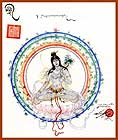|
|
|
|
|
|
|
|
Khenpo Tsultrim Gyamtso Rinpoche
|
Khenpo Tsultrim Gyamtso Rinpoche
is widely regarded as one of the most highly realized lamas of the Kagyu tradition alive today. Rinpoche was born in 1934 to a nomad family from Nangchen, Kham in Eastern Tibet. As a young man, Rinpoche embraced the life of a yogi-ascetic. For five years he wandered throughout Eastern and Central Tibet, undertaking intensive, solitary retreats in caves to realize directly the teachings he had received. During these years he often lived in charnel grounds in order to practice and master "Chod," a skillful means to cut ego clinging, develop compassion, and realize deeper levels of emptiness. |
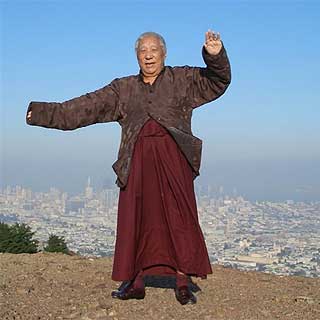
|
|
Later, Rinpoche spent nine years at the Buxador Tibetan Refugee Camp in North India. Though full of hardship, this period of his life was extremely productive: He studied and mastered the sutras, the tantras, and all four schools of Tibetan Buddhism; became renowned for his skill in logic and debate; and received a Khenpo degree from His Holiness, the 16th Karmapa, and the equivalent Geshe Lharampa degree from His Holiness, the 14th Dalai Lama.
For the past 30 years Rinpoche has been teaching both Western and Tibetan students. Rinpoche’s students often compare him to the great yogi Milarepa, whom he resembles in both substance and style: Rinpoche has no fixed abode, few possessions; he has practiced for years in solitude, sometimes sealed in darkness. Like Milarepa, he is known for his dohas, spontaneous songs of realization that offer insight into genuine reality. Such dohas may emerge to answer a question, clarify a difficult point, or to expand or comment on one of Milarepa's own songs.
More information about Khenpo Tsultrim Gyamtso Rinpoche is available at his web site:
www.ktHe is the head of the Shambhala Buddhist lineage and is spiritual director of Shambhala, a global network of meditation and retreat centers.grinpoche.org
|
|
His Eminence the Sakyong, Jamgön Mipham Rinpoche
|
|
His Eminence the Sakyong,
Jamgön Mipham Rinpoche
is one of Tibet’s highest and most respected incarnate lamas. He is unique in that he bridges two worlds: The eldest son of the Vidyadhara Chögyam Trungpa Rinpoche, who was instrumental in bringing Buddhism to the West, he is the incarnation of Mipham the Great, who is revered in Tibet as an emanation of Manjushri, the buddha of wisdom. He descends from the Tibetan warrior-king Gesar of Ling. He also holds the Kagyü and Nyingma lineages of Tibetan Buddhism.
|
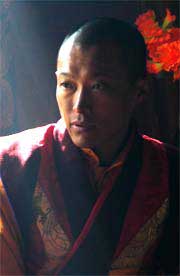
|
The Shambhala tradition believes in the inherent wisdom, compassion, and courage of all beings. It holds that these noble qualities are ultimately more stable than aggression and greed. It shows how to use worldly life as a means to ripen this spiritual potential. It practices turning the mind toward others as a discipline that creates lungta, windhorse, the ability to attain success that occurs from acting virtuously. Sakyong Mipham Rinpoche leads a worldwide community that is rooted in these principles.
The Sakyong—literally “earth-protector”—is a chögyal—“dharma king”—who holds and propagates the teachings of Shambhala. The first king of Shambhala, Dawa Sangpo, was empowered directly by the Buddha. The Shambhala tradition emphasizes confidence in the enlightened nature of all beings—windhorse—and teaches courageous rulership based on wisdom and compassion.
He is married to Princess Tseyang Palmo, daughter of His Eminence Namkha Drimed Rabjam Rinpoche, head of the Ripa lineage.
The Sakyong is a poet and an artist. He has run marathons to raise money for Tibet through the Konchok Foundation. He travels extensively, teaching throughout the world
More information about Sakyong Mipham Rinpoche is available at his web site:
www.mipham.com
|
|
Lama
Shenpen Hookham
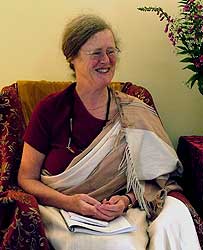
|
Shenpen Hookham spent six years as a nun, living among the Tibetans in India during the 1970’s. There she studied under such teachers as Karma Thinley Rinpoche, Bokar Rinpoche and Kalu Rinpoche. In 1978, HH the Karmapa, head of the Kagyu tradition of Tibetan Buddhism, instructed her to return to the West to teach.
Shenpen is fluent in Tibetan and has translated a number of Tibetan texts into English for her students. On the instructions of her main teacher, Khenpo Tsultrim Gyamtso Rinpoche, she produced a seminal study of the profound Buddha Nature doctrines of Mahayana Buddhism, published as “The Buddha Within”, and gained a doctorate in this from Oxford University.
Shenpen now spends most of her time in semi-retreat at the Hermitage of the Awakened Heart, in Wales, UK. From there she comes out regularly to teach, as well as giving interviews and advice to students in person and over the phone, by letter and by email.
More information is available about Shenpen Hookam at her web site: www.ahs.org.uk
|
| My experience of the Tara Dance at Panillo:
During and ever since Rigdzin Shikpo's three year retreat in Oxford in the late 80s and early 90s Khenpo Rinpoche has encouraged us to dance and sing spontaneous yogic songs and dances. Last time he was in Britain in 2005 he handed us each a big beautiful plastic lotus flower that had just been given to him and told us to dance and at that very moment his Taiwanese students rang and requested the lung of his Tara Mind Terma which Rinpoche then gave over the phone. This auspicious coincidence led him to tell me to create and dance a Tara dance for an hour a day. He told me that if I could create my own Tara dance then that was fine, otherwise I should go to Alexandra and learn from her.
Eighteen months later I was in Barcelona at the teacher's meeting in Sakyatashiling and Lama Tashi came up on the last day to see me. She told me that Alexandra would be coming at the end of the month and persuaded me to join the weekend Tara Dance in Panillo. I decided that this was an invitation Rinpoche would want me to accept and so I did.
So how did I experience the weekend?
There were many threads to the experience that were affecting me strongly. One was the joy of being welcomed so warmly by Lama Tashi and her Sangha, another was of meeting Alexandra. It was wonderful being among other Khenpo Rinpoche students and feeling that sense of his presence in the mandala. I hadnt heard Alexandra's story before, about how her Tara dance came about and how Khenpo Rinpoche and HH Karmapa had encouraged her to spread it throughout the world. This was a completely new idea for me! That we were in Spain and singing and dancing with a Spanish Sangha was an experience in itself. I love the Spanish spirit, that values and seeks that spark of life that lies in the heart and expresses itself as joy and depth of feeling - especially in song and dance. I appreciated the way, one after another, the other dancers would take me under their wing and try to help me relax into movements I wish I had been taught as a child! We English are so inhibited by comparison, but everyone made me feel I had it in me just waiting to come out. I was very touched by that.
One of the key instructions Alexandra repeated again and again was to not mind making mistakes, but to do whatever we did as if we meant it - even mistakes. This was a challenge for someone so poorly co-ordinated as myself. I watched and observed the movements she was making and was quite charmed by them. But when it came to moving my body, what I had seen with my eyes and felt in my body as she danced, didnt automatically translate into the same physical movement in me. I knew with practice it would, but we had only a few hours to practice and one movement after another being introduced in quick succession. My memory is poor at the best of times, but singing in Spanish, trying to remember the words, trying to co-ordinate them with the movements, which also needed to be remembered and placing myself in relation to the other dancers without bumping into them or squashing them against the wall was a challenge beyond my abilities. Although nothing was a mistake except to act as if one had made a mistake, I managed to make that one mistake again and again!
But that was not the point. The point was that the whole effect of working together the whole weekend on this one project of invoking the spirit of Tara and the power of the lineage through mantra, song and dance worked like magic to bring us all together, hearts, minds, voice and bodies into a single mandala or world of joy. A gateway into the reality that is the compassion and wisdom of Tara's samadhi world.
As if this was not enough, at lunch-time on the Saturday, Lama Tashi had asked me whether I would agree to give a talk at some point in the weekend on Emptiness (Rangtong and Shentong) as a taster for my possibly coming back to talk to her students in more depth on this subject. Having been received with such hospitality and kindness, I felt I owed it to her to offer what I could, although I doubted anyone would be in the mood for a deep philosophical discourse in the middle of such an intense weekend workshop on dance!
However, I greatly underestimated the company I was in. After a long discourse by Alexandra detailing the stories behind the sixteen fears, at the end of a tiring and demanding day of dance practice and training, just before dinner and with no break between Alexandra's talk and what was to follow, everyone was presented with a surprise - a discourse on rangtong and shentong by me! Nobody groaned or batted an eye and the energy in the room suddenly revived itself, ready for more. I launched forth into the space of not really knowing what I was going to say.
I think that essentially what I said was that rangtong means that what is ultimately unreal, illusory and mistaken, is empty in itself and of itself (rangtong). Anything you care to think of, anything you can grasp onto as an object of the thinking mind is like this. Madhyamaka reasoning shows us that whenever we think we have found a graspable concept, further analysis shows us that we are mistaken. We cannot pin down anything, be it self, other, time, space, the smallest indivisible speck of matter or the shortest indivisible moment of time. Whether it be out there in the world or in here in our mind, nothing can be pinned down as being anything in itself. So what is the significance of this? Does this mean that when we let go of all our concepts, the things we are grasping onto as real, that the world of our experience collapses into nothing? Or to put it another way, when we let go of clinging what happens? Do we become zombies or disappear? Or do we feel happier, freer, more loving, courageous and so on? If the latter, then why would that be? Why does letting go of clinging result in our Awakening? What is it that we awaken to? Is there a reality to awaken to?
If there is - is that also empty in and of itself? The concept of it is obvious empty in and of itself - but the essence of it? How could that be empty in and of itself? If it were empty in that way then Awakening itself would be illusion, a mistake, unreal.
That would clearly be nonsense. So to distinguish the manner in which reality itself is emptiness the term empty of what is other to it (shentong) is used. What is in essence real is empty of what is unreal and illusory. So what is in essence real? We are talking here of what we call life and experience, the heart, the heart qualities and the essence of anything at all.
For example, is our Tara dance a mere illusion, teaching us that everything is a meaningless illusion and a mistake? Of course, at this stage of our practice there is plenty of illusion and mistakes woven into our dance, but the dance itself? What is that? It is the essence of the dance itself that gives it its meaning. What is that? Can it be grasped by concepts? Can it be grasped or made an object of the mind that tries to fix and grasp onto its objects? As long as we think in that kind of heavy handed way we cannot dance. We are clumsy and what we do doesn’t lift the spirit. We know we are dancing when we are no longer bound by our heavy dualistic thinking. We are dancing when we become one with our dance. Then the dance comes to life in us. Our movements become precise, beautiful, graceful, expressive of some kind of mysterious inner essence. We who dance and those who watch us sense directly some kind of communication coming through the heart and respond accordingly. Becoming one with the dance is to rest beyond the grasping, divided consciousness that is the source of all our suffering. It is akin to awakening itself. We could dance our way to Awakening. So why don’t we?
I don’t know.
Maybe we just don’t have enough faith in and understanding of what it is we are doing. Maybe that applies to everything in our lives, not just to dance. The path of Awakening is to wake up into the immediacy of our present experience and realize that it is in itself Awakening with all the precision and beauty that is implied by that. How wonderful!
Thank you Tara, HH Karmapa, Dechen Rangdrol Rinpoche, Lama Tashi, Alexandra and all the musicians and dancers for a wonderful weekend!
|
Lama Tashi Lhamo
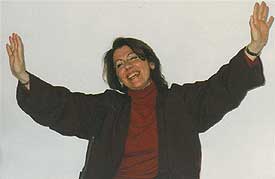 |
Lama Tashi Lhamo has been a student of Khenpo
Tsultrim Gyamtso Rinpoche, her main teacher, since 1983. From 1983 to 1988, she completed the traditional three-year three-month retreat under the guidance of Kalu Rimpoche in Kagyu Ling (France). She has lived in Spain since 1989 and, in addition to continuing her training with Khenpo Rimpoche, she teaches her many students in Spain.
Drawing on her lengthy experience as a teacher, Lama Tashi has developed a method that enables students to become familiar with Mahamudra and Dzogchen practices, right from the initial stages of their practice. At the same time her teachings closely follow the Kagyu lineage.
|
Her approach emphasizes the play of clarity and space during the experience of meditation and it is closely related to Khenpo Tsultrim Gyamtso Rinpoche’s way of teaching. Rinpoche uses songs of realisation and he often asks his student to dance.
Lama Tashi Lhamo’s sangha is known as Círculo Niguma.
Her website is: www.lamatashi.org
My experience of the Tara Dance
From my point of view as a teacher, I believe that the Tara dance is a wonderful way of connecting intuitively with what it means to “open up”.
When we dance, our open mind can enjoy the play of its natural fluidity which we usually tend to block. I believe that this is important for a meditator. Moreover, while dancing you feel upheld by the blessings of the dance, in the sacred context of what is happening.
When we open our hearts we usually feel vulnerable, and Tara’s Dance dance enables this vulnerability to express itself courageously, with dignity and power.
During the dance, a powerful energy without aggression becomes manifest and this energy is inherent to our true nature and, at the same time, ungraspable.
Yet, by allowing it to manifest, we can learn to abide there and Tara’s dance enables this to happen.
My students’ practice to date has not involved any formal deity practice but, thanks to the Tara Dance, my students have intuitively connected with her blessing, and a strong devotion for Tara has arisen in many of them. After an experience like this, during which many internal resistances have collapsed, it will be much easier for me to introduce deity practice with my students.
This openness of the heart, so skilfully guided by Alexandra, is simple and innocent. It is, in essence, a simple experience of the heart, a coming together with one’s companions, the sharing of a pleasant time. In this sense, it is not pretentious, yet it opens out to a spaciousness that allows us to connect with a sacred aspect and helps us to understand that sacredness is simple, close and humble.
Alexandra’s devotion is outstanding, as are her humility, dignity, precision and patience. She affords everyone a space so we need not worry about the little mistakes we make during the dance, thus enabling us to integrate everything as part of the experience. Her smile, her touches of humour, her calls for attention when, like children, we get distracted, mean that our shyness, fears and nervousness blossom into an experience of confidence.
Tara’s dance represents a non-aggressive courage which is full of compassion towards others and perhaps what most shines through is Alexandra’s strong motivation and her desire that this should become manifest in the lives of everyone.
As a teacher, I think it is vital to share this experience with my students because we all need this courage as the basis for our practice. That is why, whenever the opportunity arises to do this dance with Alexandra I feel honoured, and following her instructions we also perform these dances in our retreats.
Alexandra's activity is the expression of Khenpo Rinpoche's enlightened intention and his blessings, and therefore my heartfelt wish is that her activity may flourish in all directions and that, through Alexandra and Tara's Dance, Tara's blessings may reach many beings.
|
|
|
|
|
|
|
|
|
|
|
|
